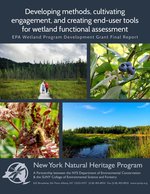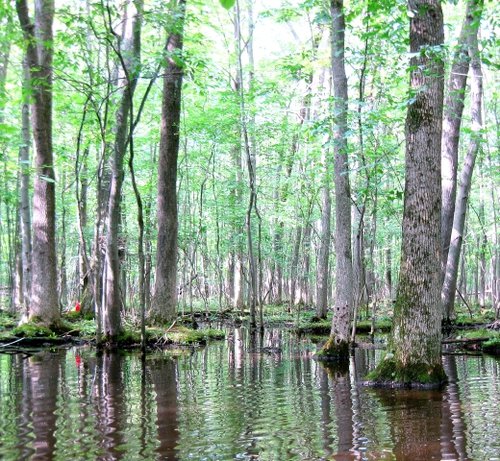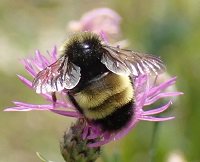Wetland Functional Assessment and Pollinator Biodiversity
Developing Methods, Cultivating Engagement, and Creating End-User Tools for Wetland Functional Assessment

Wetland Program Development Grant, EPA Region 2
Primary Contact: Laura Shappell, PhD.
Field Seasons: 2018 (pilot) and 2019
Field Sites: freshwater wetlands in the Mohawk and Allegheny watershed.
To learn more about NYS's watersheds and water quality visit NYS DEC's watersheds of NY website.
Final Report
Preferred Citation: Laura J. Shappell, Lydia M. Sweeney, and Timothy G. Howard. 2022. Developing Methods, Cultivating Engagement, and Creating End-User Tools for Wetland Functional Assessment. EPA Wetland Program Development Grant. Final Report. New York Natural Heritage Program, Albany, NY. (PDF, 12.0 MB)
We are continuing to develop the wetland functional assessment protocol. Please check back for updated information or email Laura Shappell.
Project Summary

A flooded silver maple-ash swamp in Monroe County. Photo by Laura Shappell.
Our core objective is to develop wetland functional assessment protocols that can effectively support regulatory programs and stewardship. Data from our field sampling efforts will improve our understanding of ambient wetland health in urban-rural landscapes and expand our wetland assessment dataset to include previously unsampled basins. Through collaboration with our partners at The New York State Department of Environmental Conservation and with the guidance of an Advisory Committee, we will develop a Functional Rapid Assessment Method tailored to the regulatory needs of NYS. Our first task and expected output within the first year of this project is creation of a peer-reviewed Quality Assurance Project Plan and review of established assessment protocols and literature. Functional assessment protocols will be developed and field tested during the first two years of this project through sampling in conjunction with our established three-tiered sampling approach. To increase awareness, outreach, and functionality we will develop a project webpage and a mobile data entry application for our rapid assessment methodologies. Active dissemination efforts will focus on engaging regulatory staff and other stakeholders. Training sessions and a webinar in the final year will teach attendees when and how to use the assessment protocols. These outputs will support greater accuracy and consistency in wetland functional assessment, which will lend to more accurate permitting and mitigation actions. This unique collaborative effort will expand our monitoring and assessment efforts and provide quantitative tools that can help increase the quantity and quality of wetlands in NYS.
Improving Onsite and Remote Wetland Functional Assessment: A Focus on New York City Water Supply Basins
Wetland Program Development Grant, EPA Region 2
Primary Contact: Laura Shappell, PhD.
Field Seasons: 2020 and 2021
Field Sites: freshwater wetlands in the New York City Water Supply basins and adjacent urban catchments.
To learn more about NYS's watersheds and water quality visit NYS DEC's watersheds of NY website.
Project Summary

A rare Yellow-banded Bumblebee in Warren County, NY. Photo by Laura Shappell.
Building on our previous functional assessment project, this new project expands wetland assessment protocols for New York State by developing remote functional assessment tools, refining our wetland assessment metrics, and establishing a baseline understanding of a functionally important, but poorly documented taxonomic group: pollinators. Streamlining our functional assessment protocol and developing remote (GIS) assessment tools complements our established three-tiered sampling approach (Shappell and Howard 2018), and will help us identify potential biotic or abiotic indicators of wetland condition and function. Will will be partnering with NYNHP's Empire State Native Pollinator Survey (ESNPS) to help establish a baseline understanding of pollinators in NYS wetland habitats. By collaborating with NYC DEP, we will bolster their wetland monitoring program, and receive valuable feedback on our protocols. This project will expand our understanding of wetland condition and function in NYS, and provide tools to guide wetland management, permitting, and conservation actions.
Research Topics/Keywords
ecosystem functions, ecosystem values, rapid assessment, wetland condition assessment, three-tiered assessment, wetland floristic quality, wetland functional assessment, pollinator biodiversity, wetland pollinators
Nov. 24, 2020 | Updated March 3, 2023, 2:29 p.m.